25th November - St Catherine's Day & White Ribbon day
Written by Anne Newman 17th November 2019 additions 2023
Saint Catherine's Day has retained its popularity throughout the centuries. It commemorates the martyrdom of St Catherine of Alexandria, one of the Fourteen Holy Helpers. Like St. Martin's Day on 11th November, St Catherine's Day also marks the arrival of winter.
St Catherine was beheaded by Emperor Maximinus II around 305AD in Alexandria. 25th November became the commemoration date in the 10th century, and many churches and particularly nunneries in Europe were dedicated to St. Catherine.
![]()
Catherine was the daughter of Constus, the governor of Alexandria, Egypt, during the reign of the emperor Maximinus (286–305). From a young age she devoted herself to study. A vision of Holy Mary and Baby Jesus persuaded her to become a Christian. When the persecutions began under Maximinus she went to the emperor and rebuked him for his cruelty. The emperor summoned 50 of the best pagan philosophers and orators to debate with her, hoping that they would refute her pro-Christian arguments, but Catherine won the debate. Several of her adversaries, impressed by her eloquence, declared themselves Christians and were at once put to death.
Catherine was then imprisoned and cruelly scourged, but Catherine stood with her eyes raised to heaven, without giving a sign of suffering or fear. Maximinus ordered her to be imprisoned without food, so she would starve to death. During her imprisonment, angels tended her wounds and she was fed daily by a dove from Heaven. Christ also visited her, encouraging her to fight bravely, and promised her the crown of everlasting glory.
Over 200 people came to see her, at this time including Maximinus ' wife, Caleria Maximilla and all were martyred after they all converted to Christianity. Twelve days later, when the dungeon was opened, a bright light and fragrant perfume filled it, and Catherine came forth even more radiant and beautiful.
As Maxentius had failed to make Catherine yield by way of torture, he tried to win her over by proposing marriage. The saint refused, declaring that her spouse was Jesus Christ to whom she had consecrated her virginity.
Angels transported her body to the highest mountain, now called Mt. St. Catherine. In 850, her incorrupt body was discovered by monks from the Sinai Monastery. Her hair still growing, and a constant stream of the most heavenly fragrant healing oil issuing from her body. This oil produced countless miracles.
Her relics include her left hand, said to be often warm to the touch, and her head. Her incorrupt body is not publicly displayed. Countless people make the pilgrimage to the Monastery to receive miraculous healing from Saint Catherine.
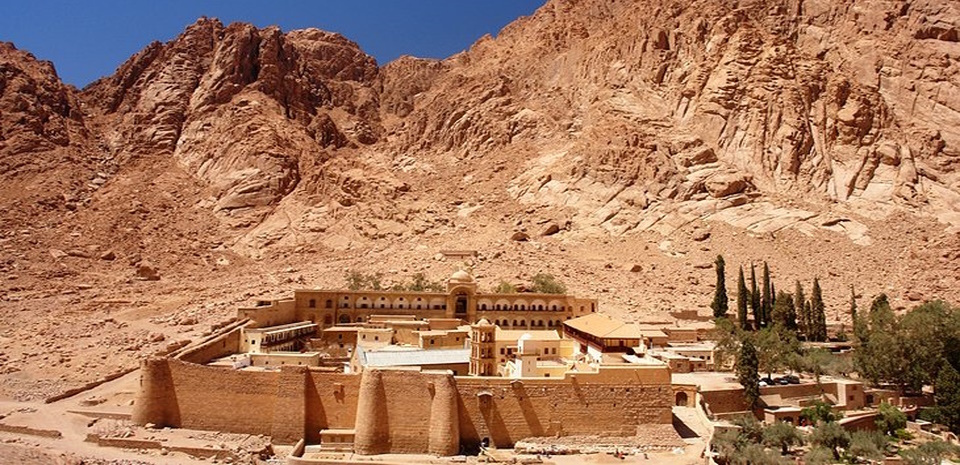
Burning Bush
Now Moses kept the flock of Jethro his father in law, the priest of Midian: and he led the flock to the backside of the desert, and came to the mountain of God, even to Horeb. And the angel of the LORD appeared unto him in a flame of fire out of the midst of a bush: and he looked, and, behold, the bush burned with fire, and the bush was not consumed.
And Moses said, I will now turn aside, and see this great sight, why the bush is not burnt. And when the LORD saw that he turned aside to see, God called unto him out of the midst of the bush, and said, Moses, Moses. And he said, Here am I. And he said, Draw not nigh hither: put off thy shoes from off thy feet, for the place whereon thou standest is holy ground.
“Come now, therefore, and I will send thee unto Pharaoh, that thou mayest bring forth my people the children of Israel out of Egypt” (Exodus 3).
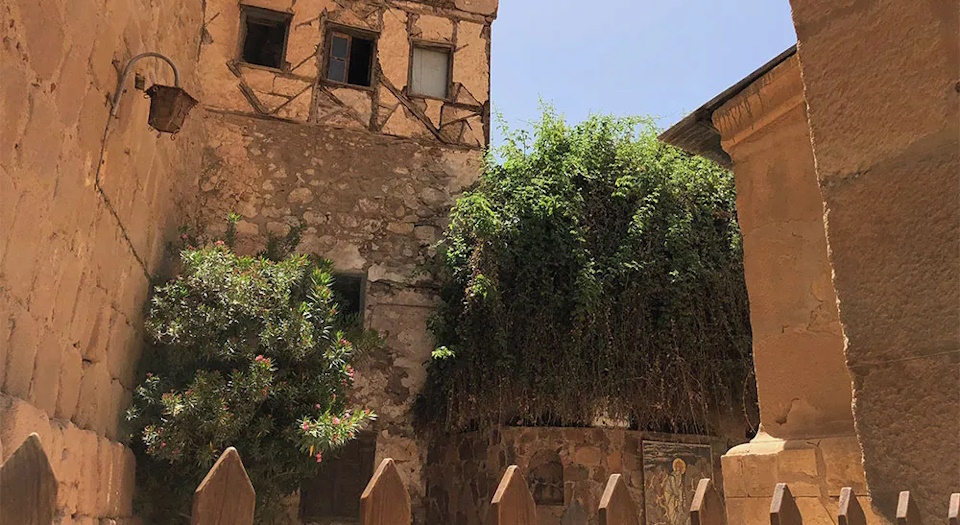
Catherine Wheel
Her principal symbol is the spiked wheel, which has become known as the Catherine Wheel.
The firework the Catherine Wheel, which rotates with sparks flying off in all directions, took its name from the saint's wheel of martyrdom.
Fresco from Cathedral of Notre Dame, Le Puy, France
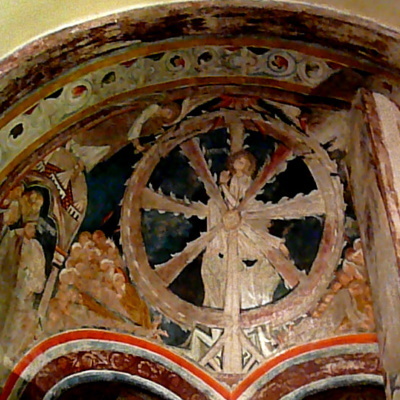 |  | ||||
Great Britain - Cattern Cakes
Catterntide was celebrated by lacemakers. A traditional celebration of St Catherine's Day, which has seen something of a revival in modern times, is the baking of 'Cattern Cakes' in honour of St Catherine. The key ingredients are bread dough, egg, sugar, lard or butter, and Caraway seeds.
Canada - Taffy
St. Catherine’s Taffy is a candy made by French Canadian girls to honour St.Catherine, the patron saint of unmarried women on her feast day. St. Catherine's Day is sometimes known in among French-Canadians as "taffy day," a day when marriage-age girls would make taffy for eligible boys.
Estonia - Kadri beggars and unshorn sheep
St. Catherine’s Day ( kadripäev) is still widely celebrated. It marks the arrival of winter and is one of the more important and popular Autumn days in the folk calendar. It is a day of celebration for the women.
The customs for the Estonian St. Catherine’s Day are generally associated with the kadrisants (kadri beggars) or kadris, which give the whole day a unique quality, although it is similar to the traditions practised on St. Martin’s Day. Both require dressing up and going from door to door on the eve of the holiday to collect gifts, such as food, cloth and wool, in return for suitable songs and blessings.
On Estonian farms, minding the herds and flocks were primarily the responsibility of women and therefore, St. Catherine’s Day involves customs pertaining more to herd keeping than farming. In addition, both men and women may dress up as women. In comparison to the mardisants (St Martin's Day), who were generally dressed in a masculine and rough manner and often wore animal masks, the kadris wear clean and light-coloured clothing, which is in reference to the coming snow.
On St. Catherine’sDay, in order to protect the sheep, shearing and weaving were forbidden and sewing and knitting were also occasionally banned.
France - Unmarried ladies of a certain age wear St.Catherine's bonnet
On St Catherine's Day, it is customary for unmarried women to pray for husbands, and to honour women who have reached 25 years of age but have not married—called "Catherinettes” in France.
| Catherinette yellow for faith and green for wisdom | 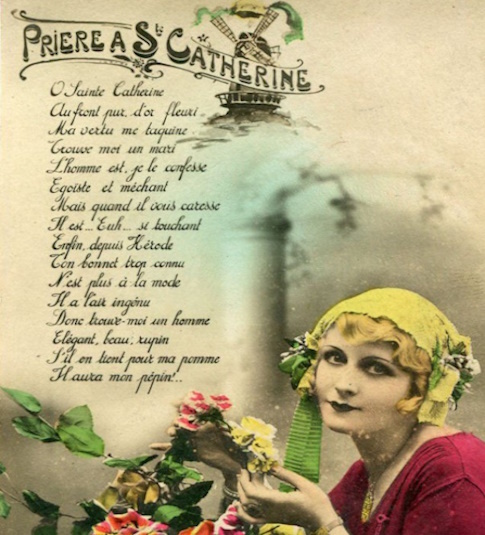 |
Pilgrimage is made to St Catherine's statue, and she is asked to intercede in finding husbands for the unmarried lest they "don St.Catherine's bonnet" and become spinsters. The Catherinettes are supposed to wear the hat all day long, and they are usually feted with a meal among friends. Because of this hat-wearing custom, French milliners have big parades to show off their wares on this day.
The French say that before a girl reaches 25, she prays:
""Donnez-moi,Seigneur, un mari de bon lieu! Qu'il soit doux, opulent, libéral etagréable!"
Lord, give me a well-situated husband. Let him be gentle, rich, generous, and pleasant!"
After 25, she prays:
""Seigneur,un qui soit supportable, ou qui, parmi le monde, au moins puissepasser!"
Lord, one who is bearable, or who can at least pass as bearable in the world!"
And when she is approaching 30:
"Un tel qu'il teplaira Seigneur, je m'en contente!"
"Send whoever you want, Lord; I'll be happy!".
An English version goes, St Catherine,
St Catherine, O lend me thine aid, And grant that I never may die an old maid.
United States - Milliners have a Hat Parade
In keeping with its French heritage, New Orleans has a hat parade to celebrate the patron saint of milliners, seamstresses and single women. Inspired by the annual event of the same name in Paris, it is held the weekend before Thanksgiving.
Ireland - a spring shot up through the floor-board of his house flooding his drawing room
Her cult has remained strongest in places like the coastal parishes of Killybegs in Donegal and Ventry in Kerry, both of which have Catherine as their patron saint. She is the patron saint of seafaring in Ireland. The only place she has this attribution.
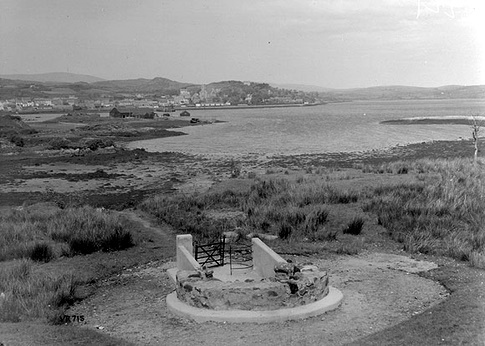
In Killybegs and Ventry pilgrimages and patrons take place at holy wells. According to legend these were long ago blessed in Saint Catherine’s name by survivors of shipwrecks, often monks, who believed the saint had intervened to spare them being drowned.
There is a St. Catherines Well at St.Doulagh's Church, in Kinsealy, Co, Dublin.
White Ribbon Day
White Ribbon Day is also known as the International Day for the Eradication of Violence against Women , and is an annual day to raise awareness of family violence. The day is run by the White Ribbon Campaign.
The colour white symbolises peace, purity and innocence.
| The White Ribbon Campaign was started by a handful of Canadian men. Two years after a Montreal massacre of 14 women on 6 December 1989,these men decided to speak out about and work to stop men's violence against women. |
---oOo---
Anne is sharing a series of events throughout the year - you can find them listed by clicking to the link Feast Days & Festivals





